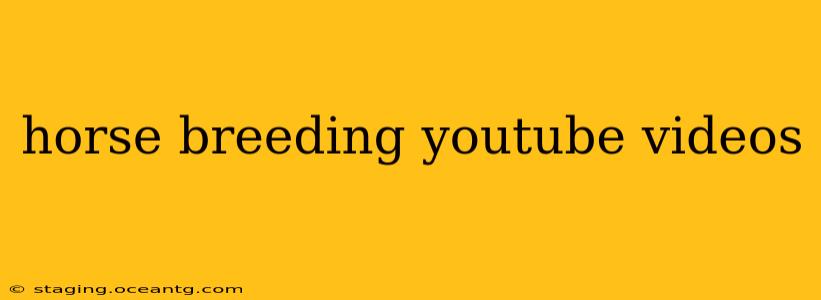The world of horse breeding is captivating, filled with intricate genetics, meticulous care, and the rewarding experience of nurturing new life. YouTube offers a wealth of resources for aspiring and experienced breeders alike, but navigating this vast platform can be challenging. This guide will help you find the best horse breeding YouTube videos, covering various aspects of this fascinating field.
What Kind of Horse Breeding YouTube Videos Exist?
The YouTube landscape for horse breeding is diverse, catering to a wide range of interests and expertise levels. You'll find videos covering everything from:
- Basic breeding concepts: These videos often explain fundamental principles like stallion selection, mare preparation, gestation, and foaling. They are ideal for beginners looking to build a foundation of knowledge.
- Specific breed information: Many channels focus on particular horse breeds, offering insights into their unique characteristics, breeding practices, and potential challenges.
- Advanced breeding techniques: Some videos delve into more complex topics, such as artificial insemination (AI), embryo transfer, and genetic testing.
- Foaling preparation and assistance: These videos provide invaluable guidance for managing the birthing process, ensuring both mare and foal safety.
- Daily care of mares and foals: From nutrition and health management to handling and training, these videos offer practical advice on raising healthy horses.
- Breeding farm tours: These videos offer a glimpse into the operations of successful breeding farms, showcasing their facilities, management styles, and breeding programs.
How to Find High-Quality Horse Breeding YouTube Videos
Finding reliable information online can be tricky. Here are some tips for finding quality horse breeding YouTube videos:
Look for Credible Sources:
Prioritize videos from established breeders, veterinarians, or equine experts. Check the creator's profile for credentials and experience. A consistent history of informative videos is a good sign of reliability.
Consider Video Production Quality:
High-quality videos often reflect a commitment to accuracy and detail. Look for videos with clear audio, good lighting, and professional editing.
Pay Attention to Viewer Engagement:
Check the number of views, likes, and comments. High engagement often suggests a well-received and informative video. Read the comments to gauge viewer feedback and identify potential issues or inaccuracies.
Frequently Asked Questions (Based on "People Also Ask" Search Results)
What are the signs of a mare in heat?
A mare in heat will exhibit several behavioral changes, including frequent urination, restlessness, and a willingness to stand for mounting. Physical signs can include a swollen vulva and clear, mucus-like discharge. The exact signs can vary depending on the individual mare.
How long is a horse's gestation period?
The average gestation period for a horse is approximately 11 months, or 335-345 days. However, there can be some variation between individual mares.
What are the risks associated with horse breeding?
Several risks are associated with horse breeding, including dystocia (difficult birth), retained placenta, and neonatal complications in the foal. Proper veterinary care and attentive management are crucial for minimizing these risks.
How much does it cost to breed a horse?
The cost of breeding a horse can vary significantly depending on various factors, such as the breeding method used (natural cover vs. artificial insemination), the stud fee (cost to use a stallion), veterinary care, and any other related expenses. Costs can range from several hundred to several thousand dollars.
When is the best time of year to breed a mare?
Most mares are bred in the spring (March-May) in the Northern Hemisphere to ensure foals are born in the spring of the following year. However, this timing depends on climate and breeding goals.
How can I find a reputable stallion for my mare?
Finding a suitable stallion requires careful research. Consider the stallion's pedigree, health records, conformation, and temperament. Seek recommendations from experienced breeders and consult breed registries for detailed information on stallions.
By using these tips and exploring the diverse content available, you can harness the power of YouTube to enhance your understanding of horse breeding and improve your success in this rewarding field. Remember, always consult with qualified equine professionals for advice tailored to your specific circumstances.
